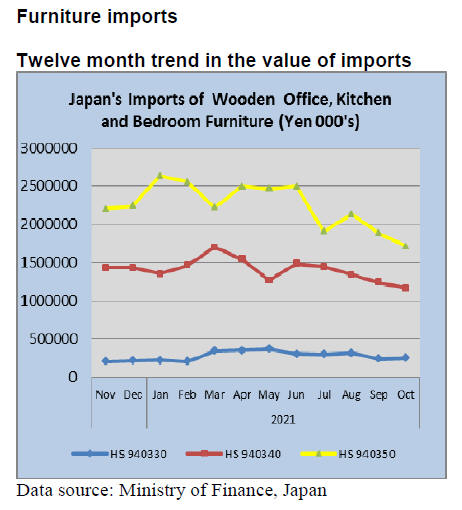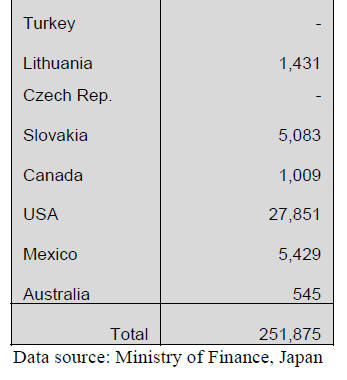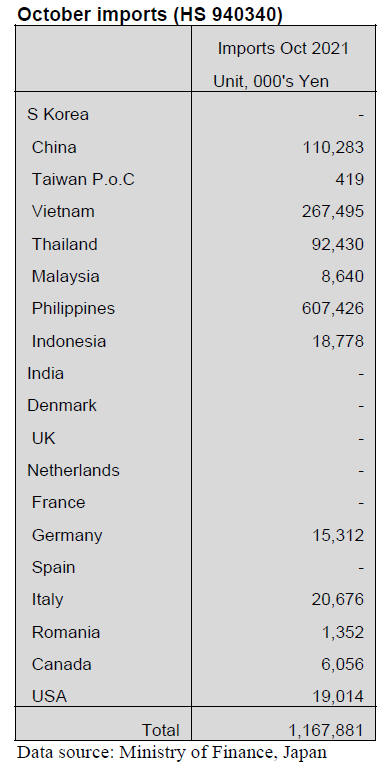Japan
Wood Products Prices
Dollar Exchange Rates of 10th
Jan
2022
Japan Yen 115.20
Reports From Japan
Private sector optimistic
Over 80% of large companies in Japan expect the
economy to grow in 2022 as personal consumption is
expected to rise but this depends on the severity of the just
beginning 6th wave of infection. 13 firms predicted the
economy will be flat as people remain cautious about the
pandemic. But none of the firms said it will contract.
The number of firms forecasting growth in the latest
survey is up from a similar poll a year earlier.
Consumers in Japan continue to hold onto their money as
they see prices of necessities rise due to higher
manufacturer input costs, rising transport cost and the
weakening of the Japanese yen.
See:
https://english.kyodonews.net/news/2022/01/48aab3e4b819-84-of-firms-in-japan-see-economic-growth-in-2022.html
Digital transition will strengthen economic recovery
says OECD
In a press release presenting the latest report on Japan the
OECD says that as the economy regains momentum
efforts can shift from emergency support measures to
targeted policies and reforms to boost labour force
participation and productivity helping to uphold growth
and living standards over the long run.
Improving public spending efficiency, including through
digitalising more government services and gradually
raising the consumption tax, which is low by OECD
standards, could help to reduce the public debt-to-GDP
ratio, ease the pressure on public finances from a rapidly
ageing population and ensure fiscal sustainability. There is
also scope to broaden environment-related taxation.
OECD Secretary-General Mathias Cormann said ¡°Japan is
on track for a steady recovery which will enable a gradual
reduction in support to the economy and a renewed focus
on structural reforms to sustain growth over the long term.
Making better use of the digital transformation and
improving business dynamism will be key to avoiding the
economic scars that persisted after previous downturns and
turn the ongoing rebound into long-lasting growth.¡±
See:
https://www.oecd.org/newsroom/japan-broaden-the-digitaltransition-to-strengthen-economic-recovery-from-covid-19-saysoecd.htm
Dip in consumer confidence indices
The Cabinet Office consumer confidence indices dipped
slightly in December and this was put down to the signs
that the Omicron variant had gained a foothold in Japan.
The Cabinet Office survey showed the overall index fell
more than the index for ¡®willingness to buy durable
goods¡¯. The December decline was the first since
September 2021.

Homes from only Japan-grown wood
Mitsubishi Estate, the house builder plans to construct and
sell single-story homes made exclusively from Japangrown
timber saying this will promote domestic forestry
and decarbonisation.
Logs will be purchased in the Kyushu region and
processed at a plant in Kagoshima. The homes will be
constructed with cross laminated timber (CLT)
components and because of the pre-fabrication Mitsubishi
homes can be ready for occupancy in about one month.
See:
https://the-japan-news.com/news/article/0008150957

Weak yen beginning to have a negative impact
on
household finances
At the start of the New Year the Governor of the Bank of
Japan (BoJ) appears to have had a change of heart saying
perhaps the costs of holding the yen down outweigh the
benefits as the weak yen is beginning to have a negative
impact on household finances as prices rise.
An analysis by BoJ staff indicated that the impact of the
yen's depreciation has pushed up prices of durable goods
in recent years. The cushion of the weak yen in boosting
exports allowed the government to put off much needed
structural reforms to free up labour markets, spur
innovation and increase productivity.
See:
https://www.forbes.com/sites/williampesek/2021/12/29/whyjapans-economy-may-surprise-us-in-2022/?sh=1060206a1c6e

Furniture growth forecast
The furniture market in Japan is expected to grow at a
strong rate up to 2026 according to growth trends for the
sector published by Mori Intelligence Japan. The Mori site
introducing its forecast say the major factors driving the
demand for furniture products in the country include rising
disposable income, increasing household and commercial
space and rising urbanisation.
It continues ¡°The market share of imported furniture in
Japan has risen significantly in the last few years. Among
imported furniture, wooden furniture occupies the largest
proportion, followed by furniture accessories, metal
furniture, plastic furniture, etc.
With low labour costs, China has become Japan's largest
furniture supplier accounting for nearly 40% of the total
Japanese wooden furniture imports. Some of the other
exporters of furniture products to Japan are Thailand,
Vietnam, Malaysia, the Philippines, Indonesia, Germany
and Italy.
The trends in Japan¡¯s housing sector are central to the
future of the furniture manufacturing sector. The current
upward trend in the country is an increasing number of
one-person households in the country, driven by changes
in culture and life-styles, which is one of the major forces
to influence furniture demand in the country.
Single-person households are the fastest-growing
household group in the country and may eventually
become the largest such group in Japan. Singles need less
space and can, therefore, save on rent and house-building
costs. Due to limited space, furniture needs to be both
pleasing and practical.¡±
See:
https://www.mordorintelligence.com/industry-reports/japanfurniture-market
Rising production costs hitting profits
In November, Inter Ikea group reported a 17% drop in
annual profits attributing the decline to a steep increase in
transport and raw material prices. Container transport
prices are at record levels as a result of the disrupted
maritime logistics and furniture manufacturers both
domestic and those overseas supplying Japan are seeing
steep increases in raw material costs which have pushed
up production costs and it is likely that other furniture
companies will also increase prices.
The domestic press has reported that Ikea, for example,
will increase retail prices by around 9% as it can no longer
afford to absorb the rising costs. It is likely that other
manufacturers will follow suit.
See:
https://japantoday.com/category/business/ikea-to-hikeprices-by-9-due-to-supply-chain-woes
Hitachi forest monitoring system to identify forest
intrusions
Hitachi, along with the US non-profit organisation
Rainforest Connection, has developed a monitoring system
to detect intrusions into forest areas which may signal
illegal activities. The system deployed relies on acoustic
data from specific forest areas and building an algorithm
to detect changes in acoustics.
The Hitachi system picks up the sound of the forest and
informs of changes such as the noise of people, trucks and
chainsaws. In this way, Rainforest Connection has
leveraged technology to promote the protection of
rainforests in many threatened countries.
https://rfcx.org/our_work
and
https://social-innovation.hitachi/jajp/article/rainforest/?WT.mc_id=21JpJpHq-rainforesttaboola&utm_source=taboola&utm_medium=native&utm_campaign=about_cop08&utm_term=all_pc&utm_content=R1_rainfor
est_PC_01&tblci=GiAfv6j0bBr1SoSJdgz0MAR5iV4szHjSQ5vNt9Fg1F5uriDVl1AogbPzxI6Iz9cL#tblciGiAfv6j0bBr1SoSJdgz
0MAR5iV4szHjSQ5vNt9Fg1F5uriDVl1AogbPzxI6Iz9cL

Office furniture imports (HS 940330)
Year on year the value of imports of wooden office
furniture (HS940330) rose over 50% in October building
on the 40% month on month rise in September. Compared
to October 2019 the value of imports in October 2021
increased.


The top shipper of wooden office furniture in
October
2021 was China taking a 66% share of the total value of
wooden office furniture imports.
Since mid year there has been a gradual decline in the
value of wooden furniture imports from China. The US
was the second ranked supplier in October 2021 at around
10% of imports with shippers in Taiwan P.o.C accounting
for around 5%. Of interest was the inclusion of Australia
in the group of top 20 suppliers in October.
Kitchen furniture imports (HS 940340)
The value of Japan¡¯s wooden kitchen furniture
(HS940340) imports continue to decline. October imports
were 6% below the value of imports in September and
compared to October 2020 there was a 30% decline.

The top shippers of wooden kitchen furniture to
Japan in
October were the Philippines (52% of all October arrivals)
Vietnam (23%) and China (9%). All three of the top
shippers saw October shipments fall below those of a
month earlier.

Since the beginning of the second quarter of this
year the
value of Japan¡¯s imports of wooden bedroom furniture
have been declining which, given the stable housing starts
and consequent demand for household furniture suggests
that domestic manufacturers could be gaining market share
over imports.
Year on year, October 2021 imports were 28% below that
in October 2020. Month on month, October arrivals of
wooden bedroom furniture were down 9% continuing the
downward trend.
The top suppliers in terms of value in October were China
(72%) and Vietnan (20%). Shipments from both China and
Vietnam in October were down being impacted mainly by
logistic problems.
The other top shippers in October were Malaysia, Thailand
and Indonesia but after capturing a 15% share of imports
in September the combined value of October shipments
from these three shippers dropped to just 5%.
Trade news from the Japan Lumber Reports (JLR)
The Japan Lumber Reports (JLR), a subscription trade
journal published every two weeks in English, is
generously allowing the ITTO Tropical Timber Market
Report to reproduce news on the Japanese market
precisely as it appears in the JLR.
For the JLR report please see:
https://jfpj.jp/japan_lumber_reports/
South Sea logs and lumber
Log production is low in producing regions in the middle
of rainy season. Logs are tight in PNG and Sarawak,
Malaysia.
Securing ships¡¯ space is difficult so even if logs are
available, there is no mean of transporting for lumber
mills. Lumber mills using South Sea hardwood logs have
difficulty to keep operating. Domestic demand keeps
continuing slowly but hasty orders are hard to accept for
sawmills by shortage of logs.
Some are transporting Malaysian logs through Taiwan. By
difficulty of obtaining containers, some orders are delayed
for a month. Indonesia is in rainy season so log production
is down.
Chinese products remain high in cost. Demand for
laminated free board is inactive by lack of demand in
Japan. In China, shortage of electric power stopped some
operations of manufacturing plants.
Price hike of domestic softwood plywood
One of major companies which produce softwood
plywood in Eastern Japan raise the price of softwood panel
to ¥1,500, 12mm thickness of 3x6. This is ¥200 per sheet
higher than before.
This is going to be ¥75,000 in a cbm which is ¥10,000
more. Not only higher prices of domestic logs and
imported veneer, but also higher price of crude oil, wood
glue and distribution cost are reasons the company raises
the prices.
24mm thickness of 3x6 is ¥3,000 and 28mm thickness
of
3x6 is ¥3,500. Both kinds will be total ¥75,000 in a cbm.
The reason is higher log cost. The amount of log harevst is
not enough as people hoped even though it is in the middle
of log harvest season.
On the other hand, demand of sawn wood and laminated
lumber is still lively because there had been many orders
from companies in western Japan as well. About 70-80%
of necessary logs are able to collect and if collecting more
logs, it has to raise the log price. It is hardly estimating the
total amount of logs would be supplied as wood producers
started cutting down trees.
People at plywood plants have difficulty in managing raw
materials because there are not enough imported logs from
Russia. Russian larch veneer¡¯s price increased and there
are less ships to Japan from Russia because of an influence
on lively demands in China. Japanese people are also
worried about there might be less Douglas fir logs from
Canada due to extensive flooding in British Columbia,
Canada in November.
There are another problem such as cost of crude oil and
natural gas increase, which made high-priced industrial
bond and some trucking companies is asking for
increasing the fuel surcharge due to the price of gasoline
increased.
Usually, it is difficult to reserve trucks at the year-end and
New Year holidays but in this year, economic activity
restarted so there are already less trucks available in the
middle of November. People at plywood companies have
to understand this condition if they really need trucks.
The demand is more than supply for the end of the year so
plywood companies must control supply carefully. No
matter how large or small demand and supply, people at
precutting plants are working very hard. Since a lack of
plywood, precutting companies hesitate to get new orders.
It will result in inconvenience for customers if we do not
control the orders and collecting plywood, a company
says. Some DIY stores could buy a half amount of orders
they want so they are suffering shortage of the supply.
Sumitomo buys New Zealand timber
Sumitomo Corporation has acquired timberland in the
North Island of New Zealand through its local subsidiary
company. Summit Forest New Zealand (SFN), 100%
subsidiary company of Sumitomo Corporation. It has
completed acquisition of 15,000 hectares of timberland
from Ernslaw One. They are 8,000 hectares in Gisborne
area and 7,000 hectares in Coromandel. Purchase amount
is not disclosed but is estimated about 102 billion yen.
SFN owns total of 37,000 hectares of timberland already
so adding the new purchase, total is 52,000 hectares,
which is seventh largest timberland owner in New
Zealand. In newly purchased timberland, log harvest of
200,000 cbms is estimated and adding harvest in already
owned timberland, total would be about 800,000 cbms.
Sumitomo sells about 350-400,000 cbms of radiate pine
logs for New Zealand domestic wood processors then
purchases about 460,000 cbms and it plans to export logs
of 860-900,000 cbms a year.
As log exporters, it is ranked fifth. The market is China.
Cycle is 28-32 years from plantation, thinning and harvest
of radiata pine timber so it is typical rotating sustained
yield business like farm products.
Sumitomo intends to invest on timber resource business,
which can be sustainable growth and trees contribute
preventing global warming trend as tress absorb carbon
dioxide and fix carbon. Sumitomo plans to invest total of
50 billion yen on forest asset including the purchase of this
time.
Sumitomo also has joint venture forest products company
in Russia, which owns 2,660,000 hectares of timberland
with forest certificate.
Iida Group Holdings bought Russian forest products
company
Iida Group Holdings, which has many house builders,
announced that it bought the largest forest products
company in the Russian Far East, Russian Forest Products
with purchase amount of 25 million dollars. This is the
largest overseas purchase in forest products business for
Japan.
RFP owns four million hectares of PEFC certified forest
with annual allowable harvest volume of 4,100,000 cbms
but actual harvest volume is only 1,700,000 cbms. It also
owns wood processing company, which consumes about
800,000 cbms of logs. Products are lumber and veneer Iida
group Holdings plan to supply wood products to house
builders in the group stably and it plans to invest for more
wood processing facilities including wood pellet.
Hokushin to increase the prices
Hokushin (Osaka prefecture), the largest MDF
manufacturer in Japan, announced that it would increase
the sales prices of MDF since March 2022 by about 10%.
The prices differ by the customers but prices of thick star
wood are about 55,000 yen per cbm and thin MDF prices
are about 71,000 yen now then since March 2022, the
prices will be 60,000 yen on star wood and 78,000 yen on
thin MDF.
Hokushin says total manufacturing cost is nearly 20% up.
Compared to March this year, electric power is 15% up,
natural gas is 40% up so total energy cost is 20% up.
Adhesive cost is 20% up. Ocean freight of imported wood
chip is up.
It consulted customers of price hike in April 2020 but by
depressed economy by the COVID 19 epidemic, the prices
are forced to drop in June and July then the prices are back
to the previous level in March 2021 and about 10% price
increase is made by October 2021 but with further increase
of the cost, it needs to increase the prices again.
Novopan to raise the prices
Japan Novopan Industrial Co., Ltd in Osaka, Japan
announced that they will raise the prices of particleboards
in January, 2022. There are two kinds of particleboards
such as floor sheathing and roof sheathing for building
constructions and housing companies of prefabricated
constructions. About 12-15% will be increased in prices.
This is the first time in ten years. The reasons are that
price hike in wood glues and materials. The particleboard
for building constructions called STP2 costs ¥1,400, 9mm
thickness of 3x10 now, but it is going to be ¥1,600.
The prices of wood working and floor board for concrete
condos had been 8% increased since August, 2021.
One of reasons is that benzene and naphtha, which are for
making adhesive for wood, cost double what it did before
so the price of adhesive jumped up by 50-70% more. Also
the company is facing a difficulty in unprofitable of
recycled wood chips due to price hike in trucking and
distribution costs.
|